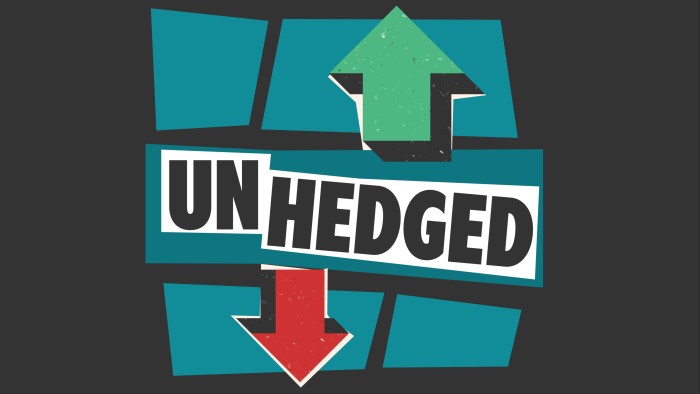This article is an on-site version of our Unhedged newsletter. Premium subscribers can sign up here to get the newsletter delivered every weekday. Standard subscribers can upgrade to Premium here, or explore all FT newsletters
Good morning. Yesterday morning it was reported that Donald Trump met congressional Republicans to discuss firing Federal Reserve chair Jay Powell. Markets freaked. In less than an hour, 2-year Treasury yields fell 6 basis points, the S&P 500 fell 0.8 per cent and the dollar dropped. The president then denied the whole thing and markets recovered. We’re not sure what game the president is playing. While he denies plans to sack Powell, there was reportedly a draft letter firing Powell, and rumours are circulating that a replacement has been selected. Email us: unhedged@ft.com.
The bitcoin rally
Bitcoin has had a nice rally in the past month or so, moving from $100,000 to $120,000:

The rally, by all accounts, has a lot to do with various bits of crypto-friendly legislation that are expected to become US law soon. The most important piece for bitcoin specifically is the Digital Asset Market Clarity Act, which will specify when a crypto asset is a commodity in the eyes of the law and when it is a security, and (correspondingly) when it is regulated by the Commodity Futures Trading Commission and when by the Securities and Exchange Commission.
Without getting into the niceties, the crypto industry has two hopes. The first is that explicit rules of the road are going to be established, and the days of “regulation by enforcement” are over. The second is a wider range of crypto assets will be classified as commodities for trading purposes, which means lighter-touch regulation.
“If a [decentralised finance] application is generating revenue, investors want to participate in that upside — with a dividend-like yield or buybacks — through ownership of a token,” says Ryan Rasmussen of Bitwise. And, Rasmussen says, the Clarity act promises such participation without the tokens necessarily being regulated as full-fledged securities.
More transparent regulation clears the way for great institutional demand for bitcoin. So, given finite supply, the bitcoin price should rise. A tidy explanation, but what happens when the last regulatory roadblock has been removed? What makes bitcoin rise then?
The argument of bitcoin bulls remains that it is a store of value. Mark Palmer, an analyst at Benchmark, argues that as regulatory clarity increases, long-term institutional ownership of bitcoin will rise too, and it will become a less volatile, momentum-driven asset, reflecting mainly the general level of market risk appetite. Instead, it will become something like digital gold. “We have seen in the last year that bitcoin has settled down a bit in terms of volatility, and less correlated to risk markets generally,” he says.
Longtime readers of this newsletter will not be surprised we are a bit sceptical of the store-of-value theory. It is true, as Palmer says, that bitcoin volatility has been lower in the past year or two than historically, and that the long-term trend seems to be down. Here, for example, is bitcoin’s 90-day volatility (the annualised standard deviation of the price over rolling 90-day periods):

But there remains a very strong relationship between the looney limits of speculative appetite and the bitcoin price. Here are the last year’s price returns for bitcoin compared with Cathie Woods’ spec-tech Ark Innovation ETF. The former looks like an even higher-volatility version of the latter:

One might point to the fact that both bitcoin and gold have had a very good few years, and see them both as part of a store-of-value-in-inflationary-times trade. But, again, the returns tell a different story. Gold chugs upward, while bitcoin zigs and zags higher:

Once bitcoin has a firm place in the financial regulations firmament, it may become less speculative and less volatile. But will this be as good for demand as the crypto bulls believe? Bitcoin’s susceptibility to emotion and momentum is, for many who trade and own it, a feature not a bug.
This newsletter has been sceptical of crypto as its price has risen, so humbleness is in order. But the store-of-value argument for Bitcoin’s value doesn’t quite add up, and the recent rally doesn’t help.
Bank results
JPMorgan, Citigroup, Wells Fargo and Bank of America — about 40 per cent of US banking, by assets — all reported earnings this week. Consistent with what we have been seeing elsewhere, the three reports reflect a solid US economy. Uncertainty and poor sentiment have, once again, failed to appear in the hard data.
Start with the consumer. Behold, believers in a faltering US economy, the charge-off rates in the credit card portfolios of JPM, Citi and BofA. All are trending resolutely sideways in the past few quarters. All three banks did better on this metric than analysts expected:

More broadly, provisions for bad loans at JPM, Wells and BofA are trending flat, while at Citi they have stuck to the same quite gentle rising trend for a while. Again, analysts have been pleasantly surprised.

Bank executives gave the usual nods to Trumpian policy-by-impulse, but they can’t help but notice that their clients are doing just fine. Citigroup CEO Jane Fraser, for example, said the economy has
. . . proven to be more resilient than most of us anticipated. But we aren’t dropping our guard as we begin the second half of the year. We expect to see goods prices to start ticking up over the summer as tariffs take effect, and we have seen pauses in Capex and hiring among our client base. All of that said, the strength of the US economy, driven by the American entrepreneur and a healthy consumer has certainly been exceeding expectations of late.
It is not hard to understand why US markets are so strong in the face of ill-conceived policy. The policies simply aren’t damaging the macro economy yet.
One good read
The detention industrial complex.
FT Unhedged podcast

Can’t get enough of Unhedged? Listen to our new podcast, for a 15-minute dive into the latest markets news and financial headlines, twice a week. Catch up on past editions of the newsletter here.
Recommended newsletters for you
Due Diligence — Top stories from the world of corporate finance. Sign up here
The Lex Newsletter — Lex, our investment column, breaks down the week’s key themes, with analysis by award-winning writers. Sign up here


